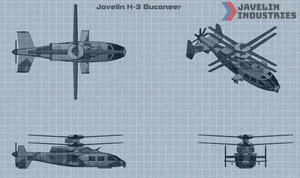Javelin H-3 Bucaneer: Difference between revisions
Continuator (talk | contribs) mNo edit summary |
Continuator (talk | contribs) No edit summary |
||
| (3 intermediate revisions by the same user not shown) | |||
| Line 74: | Line 74: | ||
*Advanced Infrared Countermeasure (AIRCM) System | *Advanced Infrared Countermeasure (AIRCM) System | ||
}} | }} | ||
In common with many designs introduced by [[Javelin Industries]], the {{PAGENAME}} had its genesis with proposals first put together during the late 1690s, but which would not fully enter into serial production until the manufacturing capacity of the still nascent Federation caught up to the ambitions of its government during the early decades of the eighteenth century ''[[after Norton]]''. | |||
A production order was placed for three hundred examples of this type in {{AN|1720}} on behalf of the [[Federal Forces of Nouvelle Alexandrie#Navy|Federal Navy]] of [[Nouvelle Alexandrie]], which was making its first tentative foray into developing an independent air arm, in the face of strident objections from the [[Federal Forces of Nouvelle Alexandrie#Air Force|Federal Air Force]], which had pushed for the adaptation of the [[Javelin H-2 Siren]] for naval operations. The irony being that the Siren and the Buccaneer shared the same airframe and powerplant, albeit the navalised Siren lacked the bespoke avionics and weapons loadout available on its dedicated maritime rival. As interservice rivals has grown inexorably, and the [[Wars of the Disinherited]] had losened many of the restraints on defence spending, [[Javelin Industries]] found itself obliged to fulfill two sets of duelling orders for essentially the same rotorcraft. | |||
[[Category:Military aviation]] | [[Category:Military aviation]] | ||
[[Category:Javelin Industries]] | [[Category:Javelin Industries]] | ||
Latest revision as of 12:16, 21 July 2023
 Javelin H-3 Bucaneer | |
| Type | Anti-Submarine Warfare (ASW) helicopter |
|---|---|
| Place of origin |
|
| Introduced | 1699 AN |
| Number built | TBD |
| Designed | 1696 AN-1699 AN |
| Manufacturer | Javelin Industries |
| Crew | 3-4 (2 pilots, 1-2 crew chiefs) |
| Capacity | Up to 5 passengers or up to 2,400 kg internal payload |
| Length | 16.5 m |
| Height | 4.7 m |
| Disc area | 176 m2 |
| Rotor diameter | 15.0 m |
| Empty weight | 7,070 kg |
| Fuel weight | 2,100 kg |
| Max takeoff weight | 13,600 kg |
| Powerplant | 2x Javelin turboshaft engines, 4,850 kW each |
| Propeller | 6-bladed variable-pitch, 2.5 m diameter |
| Maximum speed | 250 knots (460 km/h) |
| Cruise speed | 230 knots (425 km/h) |
| Ferry range | 3,200 km |
| Service ceiling | 9,000 m |
| Disc loading | 77.3 kg/m2 |
| Rate of climb | 25 m/s |
| Roles |
|
| Armaments |
|
| Avionics |
|
In common with many designs introduced by Javelin Industries, the Javelin H-3 Bucaneer had its genesis with proposals first put together during the late 1690s, but which would not fully enter into serial production until the manufacturing capacity of the still nascent Federation caught up to the ambitions of its government during the early decades of the eighteenth century after Norton.
A production order was placed for three hundred examples of this type in 1720 AN on behalf of the Federal Navy of Nouvelle Alexandrie, which was making its first tentative foray into developing an independent air arm, in the face of strident objections from the Federal Air Force, which had pushed for the adaptation of the Javelin H-2 Siren for naval operations. The irony being that the Siren and the Buccaneer shared the same airframe and powerplant, albeit the navalised Siren lacked the bespoke avionics and weapons loadout available on its dedicated maritime rival. As interservice rivals has grown inexorably, and the Wars of the Disinherited had losened many of the restraints on defence spending, Javelin Industries found itself obliged to fulfill two sets of duelling orders for essentially the same rotorcraft.